If you Like Your History with a Hefty Dose of Goosebumps, the Criminal London Night Walking Tour Will Fit You Like a Shroud
Standing at the site where Scottish hero, William Wallace was executed was enough to give me a chill in and of itself, but when Robert, our well-informed and articulate City Wonders Tours guide described, in vivid detail the utter brutality with which this great man was dispatched, I found myself immersed in feelings of both deep pity and overpowering revulsion. Welcome to one of London’s most unique and emotionally challenging walking tours.
Criminal London Night Walking Tour turned out to be somewhat of a misnomer for this two-hour sojourn into the past, but in a good way. Not only did we learn about some of London’s most famous crimes – think Jack the Ripper, but we were also regaled with stories of ghosts, gruesome historical events and ghastly living conditions.
Bobbies, Bombers and Brutality
Since a rainy evening would seem most appropriate for our tour, the weather bloke cooperated by sending us cloudy skies and intermittent showers. Robert, ever the gentleman, took pity on his soggy charges, bringing us into the smallest constabulary in London. This is a fully functioning police station. It is also the home of a tiny, but attention-grabbing museum, where we were introduced to a morbid collection of artifacts spanning over two centuries of crime and investigation.
Some of the glass cases contained various implements of destruction, such as a walking stick with a knife blade concealed in the handle, which was used in an attack on a police officer. There was also a 1913 “Suffragette bomb”, made from a mustard can, which was designed not to harm, but to bring attention to the cause. Lets hear it for the girls!
A crushed helmet worn by an officer injured in the 1973 IRA bombing at the Old Bailey, was a sobering reminder of bombs that were intended to harm. Fortunately, this particular officer did survive his injuries.
Among these and other glimpses into the past was a series of crude forensic photos of Jack the Ripper’s handiwork. Repelling, yet at the same time riveting, these depicted the brutality with which this man – or as some believe, woman – murdered five women during a six-week period in the summer of 1888, clamping the Whitechapel neighborhood in a vice-like grip of terror.
Although it is believed that the women died quickly from a first cut to the throat, they were immediately relieved of some or all of their internal organs. The Ripper even made a cruel gift of one victim’s kidney to the London Police.
Particularly disturbing was a photo showing the remains of Jack the Ripper’s last victim, Mary Kelly. Because hers was the only murder committed in a house, It is believed that her killer had more time to remove all of her organs, including the womb.
Theories abound, but the mystery of Jack the Ripper remains unsolved. Whitechapel, the neighborhood where poverty and prostitution defined its character in the latter part of the 19th century, is now a trendy area with shops, restaurants and the headquarters for counter-culture publications.
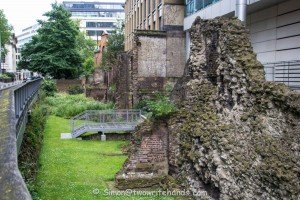
Remains of London’s Roman Wall
The City Of London covers a one square mile area within the boundaries of the ancient Roman walls, and is policed by 800 officers, many of whom specialize in white collar crimes. Metro London, on the other hand, encompasses a much larger area, with 3,100 officers. The two forces are completely independent of each other, but have a good working relationship. Metro London calls on the expertise of the London Police for assistance in solving white collar crimes, while London can make use of the Metro Police helicopters when needed.
Incarceration and Execution, London Style
We stood at the site of Newgate, England’s most notorious prison, while Robert told of bribery, corruption and a man who walked, the halls of death row, ringing his bell and taunting the condemned the night before their execution.
Built into the Roman walls in 1188, and Demolished in 1902, Newgate Prison was the starting point of many a hanging parade. According to the tradition of the day, the condemned man was put in a wagon, perched on his own coffin and driven, through streets lined with jeering on-lookers, to Marble Arch, site of the old gallows. This practice was encouraged by the government, until it was stopped in 1783, due to gentrification of the area.
Bitter-Sweet Interlude
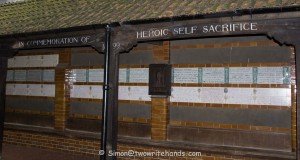
George Frederic Watts’s Memorial to Heroic Self Sacrifice
Postman’s Park brought us some short-lived relief from all the murder and mayhem. Opened in 1880, it is the home of George Frederic Watts’s Memorial to Heroic Self Sacrifice, a long wall housing 200 ceramic tiles commemorating heroic acts of ordinary people who died while saving others.
One such hero was Alfred Smith, a London Police Officer, who in 1917 rescued 150 women from a factory set ablaze by a Zeppelin raid, in which he lost his own life.
A free mobile app, “The Everyday Heroes of Postman’s Park”, is available for those who want to learn more about the brave and selfless individuals commemorated on the memorial.
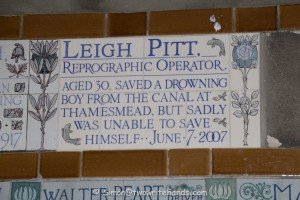
One of the More Recent Additions to the Wall of Self Sacrifice
Fifty Shades of Death
Following our brief moments of reflection on the brave and generous self-sacrificing spirit of mankind, we were unceremoniously jolted back to reality by our dedicated tour guide.
Now, if I tell you everything we saw on our tour, it will spoil the fun when you take it. And I do recommend you take it. So here are just a few more tantalizing tidbits to whet your appetite:
- The macabre meat-packing district of Smithfield: Back in the 16th Century, it wasn’t just cows, pigs and chickens that had to worry. This was the execution site where Bloody Mary, King Henry VIII’s eldest daughter sat in a tower window, enjoying roast chicken and red wine, while she watched heretics burn. Believing she was doing them a favor , she ordered that white pine be used for the pyres, so as to make the flames as hot as possible. Fortunately, this crazed religious zealot;s reign was short-lived due to what was believed to have been stomach cancer. Maybe it was all that roast chicken and red wine. What made the scene even more eery was the subtle, but unmistakable, smell hanging in the air of raw meat. Robert told us that London cabbies have reported hearing supernatural sounding screams while driving the Smithfield neighborhood late at night. “And London cabbies never lie,” he said with a wink.
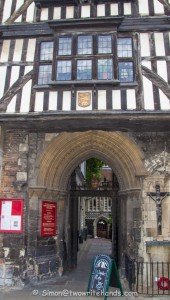
The Window Allegedly Used by “Bloody” Mary to Watch the Burning of Heretics
- The plague was really the pits: Robert pointed out a series of humps in the road. He explained that these were the locations of 17th century plague pits, still containing the remains of victims of the devastating disease that wiped out half the population of London. Contrary to tall tales and science fiction and horror stories, it is highly unlikely that opening these 17th Century cans of worms would release the deadly virus back into the atmosphere.
- A famous priestly pad: We saw the site of the house where Thomas Becket, Arch Bishop of Canterbury in the 1190’s lived. He managed to get on the wrong side of Henry II, who proclaimed, “Would somebody rid me of this troublesome priest?” So, in one of England’s most notorious crimes, Becket was cut down at the alter by four of Henry’s noblemen.
- Guardians of the dead: Robert told us of various ways in which medical researchers and teachers acquired their cadavers. Grave robbing was once a popular pastime, so families would hire watchers, who would sit in towers long enough for the buried bodies of their loved ones to be of no earthly use. These grave robbers who roamed the night were known as the Resurrection Men. Robert took us to the last remaining watch tower, where men once earned a living keeping a watchful eye on the newly deceased.
- St. Bartholomew Hospital’s most recent claim to fame: On a lighter note, Robert pointed to the spot on the roof of St. Bart’s where Sherlock Holmes jumped to his supposed death at the end of the last episode of Season II of the Sherlock television series. So beloved is this modern-day incarnation of the famous fictional detective that people brought flowers and other expressions of grief to the area outside the hospital. Some people really do need to get a grip on reality. Of course, when Season III began with a live Sherlock, sanity reigned once more.
- A grizzly bar: The last stop on our tour was the cellar of the crowded and noisy Viaduct Tavern, which hides a 18th century debtors prison. After descending a set of narrow steps, we pass through the pub’s storage area and came face-to-face with many-a-man’s worst nightmare. The prison held cold, dark cells that were closed off by iron gates at night, making them even more tiny than they were when open. Each cell contained 12 small metal cubicles where prisoners slept, along with their few possessions.
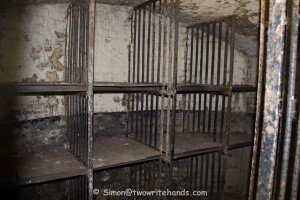
Debtors Prison – London Style
There were holes in the ceiling from which families could drop food and other comforts down to suffering loved ones below. Ghost evenings are sometimes held in the former prison, where visitors can spend the night waiting around for a ghost, or what ever they do down there. I think I’ll pass on that one. After all, it’s unlikely that they have reliable wi-fi. Robert tells us that he believes he may have had an encounter with a ghost at the heavy door going down into the cellar. But I’ll let him tell you about it himself.
And so ended our venture into London’s darkest memories. Rest assured that, if you follow in our footsteps, the experience will haunt you for years to come.
For more information about the Criminal London Night Walking Tour, visit http://www.citywonders.com

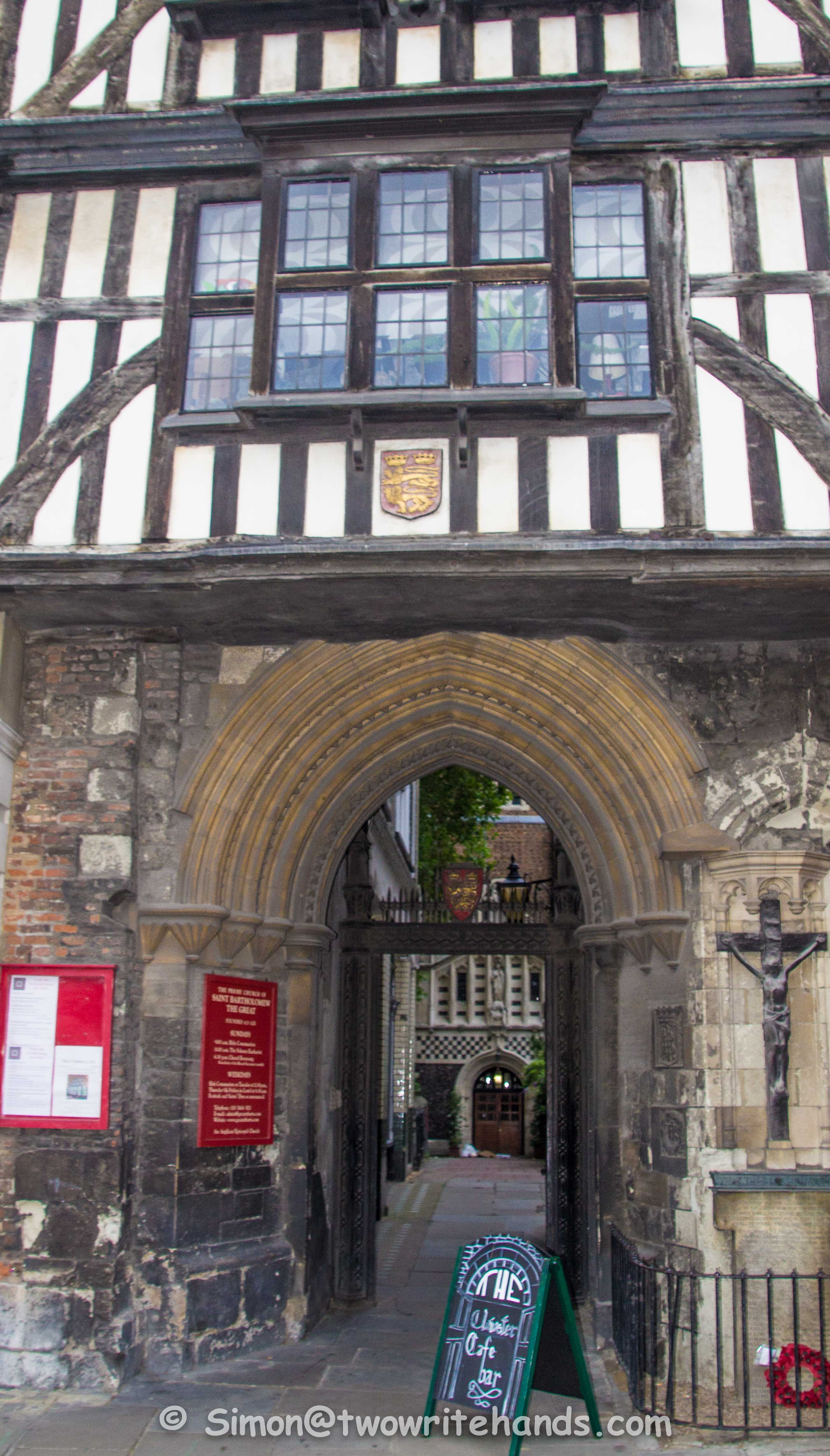



Thank you, Lydia. So glad you enjoyed the post. Hope you make it over to England soon. It’s an amazing country, and there’s so much to see and do that one trip just isn’t enough. When you start making plans, please feel free to contact me, and I’ll be glad to help you as much as I can.
Just now got around to reading this and thoroughly enjoyed it! I’m hoping I’ll be able to make a trip to England one of these days.
Thank you. Nice to know you have a similar appreciation of the creepier side of life. 🙂
Appreciated the creepy tour of London. You have quite a way to pull the reader into your stories .
Thank you, Tanya. I hope you get back to London some time soon.It really is an amazing city!
Penny, This was a fascinating article! Having lived in England and visited many of these places as well, I can feel my memories as I read your words. Thank you for sharing this amazing experience!!!! Tanya